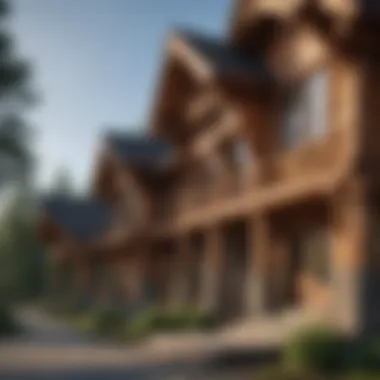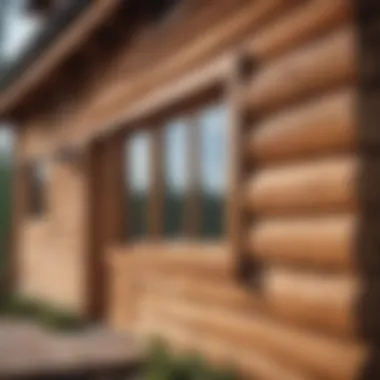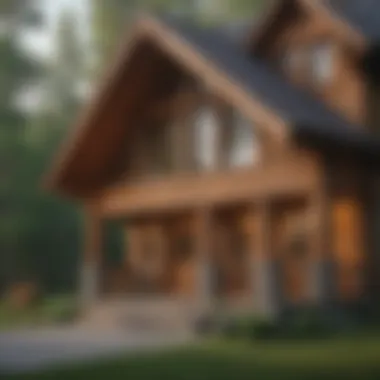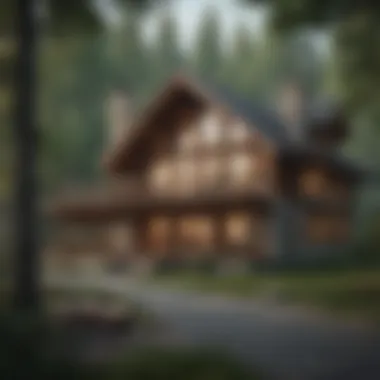Understanding Insurance for Log Homes: Coverage Insights


Intro
The insurance landscape for log homes presents unique challenges and opportunities. Many homeowners may not realize that traditional homeowner’s insurance might not cover the specific elements that log homes entail. This guide is intended to bring clarity on how to adequately protect these distinctive structures through appropriate insurance coverage.
Log homes are often built in ways that make them more vulnerable to certain risks. Given their wooden composition and distinct construction methods, they require tailored insurance policies. A comprehensive understanding of the available coverage options and considerations is essential for log home owners to make informed decisions about protecting their investments.
In various markets, different insurance providers offer varying levels of coverage specifically designed for log homes. Exploring these options, as well as the specific needs of homeowners, will help illuminate the path to securing the right policy. The aim here is to break down the complexity into manageable information, making it easier for homeowners to navigate the insurance sphere effectively.
Prolusion to Log Home Insurance
Insurance for log homes serves as a fundamental element in safeguarding an investment that is unique in structure and framework. This type of insurance is not only vital for protection against unforeseen incidents but also plays a crucial role in ensuring peace of mind for homeowners. Log homes are distinct due to their materials and designs, factors that influence coverage needs. Each log structure comes with individual characteristics that standard homeowner's insurance may overlook. This makes specialized insurance options necessary, providing tailored policies that address specific risks.
When considering the financial implications of owning a log home, understanding the specifics of insurance becomes imperative. Log homes often require different approaches than traditional dwellings. Elements such as the likelihood of pest intrusion or the potential for log deterioration over time can significantly influence insurance coverage. Homeowners must examine their unique circumstances, ensuring their insurance plan aligns with their home’s construction, location, and potential hazards.
The aim of this section is to lay the groundwork for a deeper exploration into the landscape of log home insurance. By understanding the unique aspects of insurance that pertain to log homes, the subsequent sections will guide readers through the various options available, the factors that affect premiums, and ways to effectively navigate the claims process.
The Increasing Popularity of Log Homes
Log homes have seen a resurgence in interest in recent years. Their appeal can largely be attributed to a combination of aesthetic charm, energy efficiency, and the promise of a unique living experience. Many people are drawn to the rustic allure of logs combined with modern conveniences. These homes offer a closeness to nature, often becoming a retreat from urban life. As a result, demand for log homes has increased, with more potential homeowners considering them as viable options.
In addition, log homes often appeal to those who value sustainability. The materials used in log building are often sourced responsibly, aligning with growing concerns for the environment. The interest is not only limited to primary residences; many pursue log home ownership for vacation properties or rental investments. This increased interest subsequently raises the need for suitable insurance, which protects these investments while catering to their specific needs.
Why Specialized Insurance is Necessary
Specialized insurance for log homes addresses several factors that standard policies may overlook. Traditional homeowner insurance typically does not account for the unique risks associated with log construction, such as their greater susceptibility to rot, pests, or fire incidents. Log homes inherently require different maintenance levels and protective measures, which necessitate insurance policies that reflect those capabilities.
Moreover, the market for log homes is not as widespread, resulting in fewer companies specializing in this niche. A tailored insurance plan provides better coverage terms that can meet a log home owner’s specific needs. Below are key reasons specialized insurance is necessary:
- Coverage Differences: Log homes face unique environmental conditions, making them more susceptible to weather-related damages. A specialized policy ensures adequate protection.
- Home Value Fluctuations: Log homes may appreciate differently than conventional homes; insurance must account for these variances in value.
- Liability Coverage: These homes may attract visitors more often, increasing the need for robust liability coverage, especially for vacation rentals.
Ultimately, having a solid understanding of how log home insurance differs is essential. Homeowners should seek coverage options specifically designed for log structures to ensure they are never underinsured.
Unique Characteristics of Log Homes
When considering insurance for log homes, it is essential to understand their unique characteristics. These homes are not just traditional structures; they are often built with specific materials and techniques that demand specialized coverage. Log homes may appeal to many because of their rustic charm and connection to nature. However, these features can lead to challenges in insurance that homeowners must navigate.
Construction Materials and Techniques
Log homes are primarily constructed from logs, which are fundamentally different from the conventional building materials like brick or wood frame. Logs used in construction typically come from various types of trees, including pine, cedar, and spruce. This choice affects both the home’s aesthetic and its insurance implications. The durability of the wood, as well as its resistance to pests and rotting, can significantly impact the overall risk assessment.
Homeowners should be aware that some logs are treated for protection against insects and decay. These treatments provide an added layer of security. However, they can also complicate insurance evaluations. Some insurers may require appraisal or additional assessments to ensure the logs are in good condition before offering coverage.
The building techniques for log homes also differ. For example, chinked logs involve a meticulous process of sealing the gaps between logs. This is crucial for insulation and moisture control. Homes built with this technique might face different risks and therefore different premiums. It's vital for homeowners to discuss these techniques with their insurance agents to find out how they affect coverage.
Maintenance Challenges
Maintaining a log home presents its own unique set of challenges. Unlike conventional homes, log cabins require regular upkeep to prevent issues with decay and insect infestations. Log homes are susceptible to moisture problems, which can lead to mold growth or damage if not addressed promptly. This is an important consideration when discussing insurance, as preventive measures can lead to lower premiums.
Homeowners must frequently check for signs of wear, such as cracks, fading finishes, or water damage. Ignoring these maintenance aspects can not only affect the home's integrity but can also lead to claims being denied if a loss occurs due to negligence. Moreover, insurers often evaluate a homeowner’s previous maintenance practices when determining policy terms.
In summary, while log homes offer distinctive beauty and charm, their unique characteristics necessitate a more tailored approach to insurance. Conscientious maintenance and a solid understanding of the construction methods are key factors for homeowners to consider as they assess their insurance needs.
Types of Insurance Coverage for Log Homes


When it comes to protecting a log home, understanding various insurance coverage options is critical for homeowners. The unique structure and materials used in log homes necessitate specialized policies that account for their distinct risks and characteristics. The following sections explore these coverage options, highlighting their importance and the peace of mind they offer to log home owners.
Basic Dwelling Coverage
Basic dwelling coverage serves as the foundation of any homeowners insurance policy. For log homes, this type of coverage typically protects the physical structure against common risks, such as fire, theft, and certain natural disasters. Given the natural materials used in log homes, it is paramount to ensure adequate coverage that takes into account potential vulnerabilities.
Homeowners should carefully review the policy details to understand what is included. Some policies may not cover specific perils that are more prevalent for log structures. Thus, it may be wise to choose a policy that offers broader protection. Additionally, verifying that the coverage limits are sufficient relative to the rebuilding cost of the home is crucial, given the potential rise in costs regarding log home reconstruction should a loss occur.
Liability Coverage
Liability coverage is another essential aspect when insuring a log home. This insurance protects the homeowner from potential lawsuits related to injuries or damages that occur on their property. For log home owners, this can include risks associated with natural elements, such as falling branches or uneven walkways. If a visitor suffers an accident on the property, liability coverage can cover legal fees or medical expenses, preventing financially burdensome consequences.
When selecting liability coverage, homeowners should be aware of the policy limits. These limits should ideally reflect the home’s location and potential liability risks. Higher coverage limits may be advisable for enchanting but sometimes unpredictable environments.
Additional Living Expenses
Additional living expenses (ALE) coverage is beneficial for homeowners who find themselves displaced due to a covered loss. If a log home sustains significant damage from a fire or severe weather, ALE can provide necessary funds to cover temporary housing costs. This coverage ensures that homeowners are not left to bear these costs alone while their home is being repaired.
Homeowners should assess their policies to confirm the extent of ALE coverage, including how long assistance will continue and the maximum amount available. A thorough understanding will allow individuals to make informed choices about their insurance needs.
Replacement Cost vs. Actual Cash Value
When insuring a log home, homeowners must navigate the choice between replacement cost and actual cash value (ACV) coverage. Replacement cost coverage ensures that the homeowner can replace their damaged property without deduction for depreciation. This means if a log home is destroyed, the insurance would cover the cost of rebuilding it regardless of the original value.
In contrast, actual cash value coverage factors in depreciation, meaning a payout will be based on the property’s current value minus wear and tear. While ACV premiums are usually lower, the potential financial disadvantage is considerable. Homeowners should carefully evaluate their long-term financial situation when selecting between these two options, as the implications can significantly impact recovery after a loss.
"Choosing the right insurance coverage is essential for safeguarding your investment in a log home. Each type of coverage addresses specific needs and risks."
Understanding these various coverage options sets the foundation for log homeowners to make intelligent and informed decisions regarding their insurance policies.
Factors Affecting Insurance Premiums for Log Homes
Understanding the various elements that influence insurance premiums is essential for log homeowners. Insurance costs can vary significantly based on numerous factors. Homeowners must grasp these influences to adjust coverage accordingly and prepare for potential variations in pricing.
Location and Risk Assessment
The geographical location of a log home plays a crucial role in determining the insurance premium. Insurance companies evaluate the risk associated with various factors such as weather patterns, crime rates, and proximity to emergency services. For instance, homes in areas prone to wildfires or flooding will typically face higher premiums due to the increased risk of damage. Urban dwellings may also differ in rates compared to their rural counterparts, often influenced by the available amenities and emergency response times. It is essential to provide accurate location details when seeking insurance quotes.
Home Value and Replacement Costs
The overall value of the log home is directly tied to the premium cost. Insurance policies are designed to cover the full replacement cost or the actual cash value of the home. Replacement cost refers to the amount needed to rebuild the home using similar materials at current market prices. Actual cash value takes depreciation into account, resulting in a lower payout. Homeowners should regularly assess their home's value to ensure that their coverage matches current market conditions, as fluctuations can occur frequently, affecting premiums.
Previous Claims History
A log homeowner's past claims history significantly impacts insurance premiums. Insurance providers typically view previous claims as an indicator of future risk. If a homeowner has a history of regular claims or substantial incidents, they might encounter higher premiums. Conversely, a clean claims history could yield discounts, reflecting a lower risk profile. Therefore, careful management of property and prompt repairs after incidents may help mitigate future costs.
Building Codes and Regulations
Compliance with local building codes and regulations can also affect insurance premiums for log homes. Unique features like specific construction methods used in log homes may require adherence to additional safety standards. Areas with stringent codes may lead to a higher cost in terms of compliance, thus influencing the overall insurance premium. Insurers typically favor homes built to modern standards, considering them lower risk. Understanding and maintaining compliance can be beneficial for homeowners aiming to reduce their premiums.
Common Insurance Providers for Log Homes
When it comes to insuring log homes, selecting the right insurance provider is crucial. Providers differ in terms of coverage options, pricing, and their understanding of the unique aspects of log homes. Not all insurance companies have experience with these specialized structures, making it essential to find a provider that is knowledgeable and offers tailored coverage.


Many insurance providers may not fully comprehend the unique risks associated with log homes. Thus, consulting with companies that specialize in log home insurance or have a clear understanding of these types of properties can be advantageous. This guide will explore both national and regional companies, as well as specialty providers, helping homeowners make informed decisions about their insurance needs.
National vs. Regional Companies
National insurance companies have a wide reach and often provide a variety of coverage options and discounts. They typically have established reputations and brand recognition, which can instill a sense of trust in policyholders. However, they may not have the best understanding of local conditions affecting log homes. Their generic policies may not offer adequate protection tailored to the characteristics of these homes. Homeowners could find that their specific needs are not met, ultimately causing dissatisfaction when a claim arises.
On the other hand, regional companies often cater to specific geographic areas. They tend to have deeper understanding of local building codes, climate risks, and the general market for log homes. This can lead to more personalized service and better insurance products that suit homeowners' specific needs. The regional companies may also offer competitive pricing due to their focus on local markets. However, they may not provide as wide a range of options compared to national providers.
When evaluating these companies, consider the following:
- Coverage Options: Check if the provider specializes in log home insurance and what kinds of policies they offer.
- Customer Reviews: Look for feedback from other log home owners to gauge the customer service experience and claims process.
- Financial Stability: Ensure the provider has a solid financial background to fulfill claims effectively.
Specialty Insurance Providers
Some insurance companies specifically focus on niche markets, including log homes. Specialty insurance providers understand the intricacies involved in insuring such properties. They can offer policies that address distinct risks like wood rot, pest damage, and weather-related issues common for homes made of logs.
Choosing a specialty insurance provider can pay off significantly. Here are the benefits of such providers:
- Tailored Coverage: These companies usually have specific policies designed for log homes, allowing homeowners to get the protection they need.
- Expertise: Specialty providers understand the unique challenges associated with log homes and can better assist when it comes to claims.
- Flexibility: They are often more adaptable to the needs and requests of insured homeowners compared to larger, more rigid companies.
"Finding an insurance provider that specializes in log homes can save you time and money, ensuring your unique needs are met."
The Importance of Policy Customization
When it comes to insuring log homes, customizing your policy is crucial. Each log home has distinctive features that can significantly influence its insurance needs. For instance, the construction materials, design, and location can all impact how you should tailor your coverage. Having a one-size-fits-all insurance policy can leave gaps that may expose homeowners to considerable risks.
Tailoring a policy not only provides better protection but can also lead to more cost-effective coverage. Homeowners should take time to review their specific needs and address areas that may not be covered under a standard policy. This process ensures adequate protection against potential losses while maintaining manageable premiums.
Assessing Individual Needs
Assessing individual needs is the first step in customizing an insurance policy. The needs of one log home may differ vastly from another. Factors to consider include the size of the home, its age, and the materials used in construction. Homeowners should also reflect on local risks such as weather events or wildfires that can affect their surroundings.
Another important consideration is the homeowner's personal assets and lifestyle. If a homeowner has valuable collectibles or unique installations, it’s essential to factor those into the coverage plan. Each unique aspect can create specific risks that necessitate tailored coverage.
Understanding Policy Exclusions
Understanding policy exclusions is key to navigating insurance for log homes. These exclusions are sections of the policy that outline what is not covered in the event of a claim. Common exclusions may include natural disasters like floods or earthquakes, which could be particularly relevant depending on the home's location.
Homeowners must thoroughly review the policy document and inquire about specific exclusions. This proactive approach helps to avoid surprises during a claims process. If exclusions are not acceptable, discussing additional coverage options or endorsements with the provider can be beneficial.
Additional Endorsements and Riders
Homeowners might consider additional endorsements and riders to enhance their insurance coverage. Endorsements expand or modify coverage for specific risks that the standard policy might not cover. For example, if a home is in a fire-prone area, adding fire insurance specifically might be wise.
Riders can also be included to provide comprehensive protection for specific personal property or unique circumstances. Homeowners must evaluate these options as they can provide peace of mind while protecting against unexpected events. Considering additional riders often leads to more robust and secure insurance coverage tailored to the unique risks faced by log homes.
The importance of policy customization cannot be overemphasized; it transforms a standard insurance policy into a tailored solution for unique needs and risks.
Navigating the Claims Process
Navigating the claims process is a crucial aspect of log home insurance. When faced with damage or loss, understanding the procedure can significantly impact the recovery experience. This process can often be complex, but knowing the right steps can facilitate quicker resolutions and ensure that homeowners receive their entitled compensation. A robust claims process is vital because it includes not only notification of loss but also thorough documentation and negotiation for claim settlement.
Initial Steps After a Loss


The immediate steps taken after a loss can set the stage for a smooth claims process. The first action should be to ensure safety. If there is a significant threat, such as fire or structural hazards, evacuate people from the area and call for professional help. Once everyone is safe, contact your insurance provider to report the loss. This initial notification is important, as most policies have time requirements for reporting incidents. The sooner you notify your insurer, the better.
Documenting Damage and Losses
Documentation plays a critical role in reinforcing your claim. Start by taking clear photos of the damage. These images serve as visual evidence for your insurance company. Make a detailed list of affected items, including their values and any receipts or warranties if available. You may also want to gather witness statements if applicable. This written documentation can address questions about the event that caused the damage and is essential in supporting your claim.
Understanding Claim Settlement
Understanding how claim settlements work is important for homeowners. Insurance companies typically assess the damage based on the information and documentation submitted. They may send an adjuster to inspect the property, which adds another layer to the process. Be prepared for this visit by having all your documents organized and ready. After the evaluation, your insurer will communicate the settlement offer, which will be based on the coverage outlined in your policy - whether it's replacement cost or actual cash value.
It’s critical to carefully read the settlement offer and ask questions to clarify any ambiguities. Failure to understand the terms could affect your ability to challenge any decisions.
Navigating the claims process requires vigilance and organization. Being proactive can make a significant difference in how effectively and swiftly you recover from a loss.
Tips for Reducing Insurance Costs
Reducing insurance costs is an essential aspect for log home owners. The right strategies can lead to significant savings. Homeowners have options to decrease their annual premiums while maintaining necessary coverage. Cost reductions are possible through various methods ranging from policy bundling to regular maintenance.
Bundling Policies
Bundling insurance policies refers to the practice of purchasing multiple types of insurance from one provider. Many companies offer discounts for those who choose to combine different policies, such as home and auto insurance. This approach not only simplifies the management of your policies but may also lead to lower premiums.
Benefits of bundling include:
- Cost Savings: Discounts can range from 10% to 25% on your premiums, depending on the provider.
- Streamlined Payments: One payment for multiple policies simplifies financial management.
- Easier Claims Process: Working with one insurer may result in more efficient handling of claims across different policies.
Increasing Deductibles
A deductible is the amount a policyholder must pay out of pocket before an insurance company covers the remaining costs. Increasing your deductibles is another effective way to reduce insurance costs. When you opt for a higher deductible, your premium typically decreases. This is because you are assuming more financial responsibility in the case of a loss.
However, this decision should be made carefully. Consider the following factors:
- Financial Stability: Ensure you have enough saved to cover potential high out-of-pocket costs in the event of a claim.
- Risk Evaluation: Assess your home’s specific risks to determine if a higher deductible is a sound choice.
Regular Home Maintenance
Maintaining your log home is vital to protecting its value and minimizing insurance costs. Insurance providers often assess the condition of a home when determining premiums. Well-maintained homes are less likely to incur damage and have fewer claims. Regular maintenance tasks include:
- Inspecting and Treating Logs: Regular checks can prevent rot, insect damage, and other issues.
- Roof Maintenance: Ensure the roof is free of debris and perform any necessary repairs to avoid leaks that can cause significant damage.
- Safety Inspections: Addressing potential hazards and ensuring smoke detectors, fire alarms, and security systems are in working condition can further lower risks.
"The safest homes typically pay lower insurance premiums. Taking proactive steps can lead to significant savings."
In summary, lowering insurance costs involves a combination of strategies. These include bundling policies with one insurance company, considering higher deductibles, and maintaining a rigorous home maintenance schedule. Implementing these tactics can lead to both immediate and long-term financial benefits.
End
Understanding insurance for log homes is crucial for homeowners seeking to protect their investments. This segment sums up the integral aspects of insuring a non-traditional structure like a log home. The complexity of log home insurance requires careful consideration of various factors, including coverage options, assessment of risks, and understanding the nuances of claims processes.
Log homes present unique challenges and benefits when it comes to insurance. These advantages often encompass durability and aesthetic appeal, while challenges can include higher maintenance costs and susceptibility to pests. Homeowners need to be aware of these factors for informed decisions.
Additionally, policy customization emerges as a significant element in mitigating risks. Without tailoring an insurance plan to fit specific needs, coverage gaps may occur, leaving homeowners vulnerable during claims. Essential considerations should also include understanding exclusions, limits on coverage, and the impact of location on premiums.
Ultimately, familiarity with various insurance providers and their offerings provides homeowners a degree of agency. Choosing between national and regional companies, or exploring specialty options may affect overall satisfaction with coverage. The insurance market is diverse, and taking the time to investigate these alternatives can lead to significant long-term benefits.
Final Thoughts on Log Home Insurance
In summary, log home insurance necessitates a thorough understanding of both the log home characteristics and the wider insurance landscape. Homeowners are encouraged to ask the right questions and seek advice tailored to their specific situations.
Some key takeaways include:
- Evaluating needs: Conducting an assessment helps determine what coverage is essential.
- Policy nuances: Having a grip on exclusions and limitations fosters better preparedness.
- Research options: Investigating both national and regional providers can unearth suitable plans.
By fully grasping these components, homeowners can approach insurance with confidence, ensuring their log homes are well-protected against unforeseen events.



